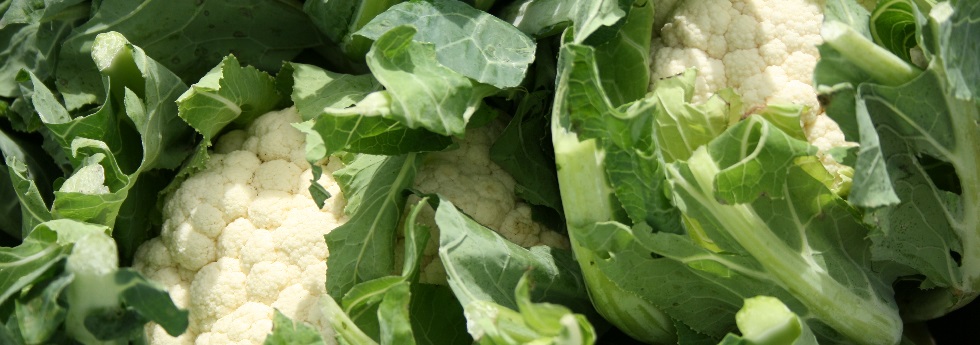There are no products listed under this category.

Cauliflower is a cool-season crop closely related to broccoli, cabbage, kale, turnips, and mustard. Unlike many of its relatives, cauliflower has more demanding climatic needs, performing best in cool, moist conditions. The plant is highly sensitive to stress from extreme heat, drought, or freezing temperatures, which can cause it to produce small, underdeveloped heads known as "buttons." Grown for its edible head, often called a "curd" due to its resemblance to cheese curds, cauliflower is most commonly white. However, some varieties feature striking colors like purple, orange, or green, adding diversity to this versatile vegetable.
Cauliflower thrives in well-drained, fertile soil rich in organic matter, with a pH range of 6.0 to 7.5. Consistent moisture is essential throughout the growing season, so regular irrigation is recommended for optimal growth. This crop does not tolerate hot weather well, making it most successful when planted for spring or fall harvests.
Performs best at temperatures below 80°F.
Plant in full sun areas.
TRANSPLANTING:
Sow seeds 4 to 6 weeks before transplanting using one of the following methods:
Maintain soil temperatures above 70°F for germination, then reduce to 60°F. A seedling heat mat can help regulate temperatures during germination. Once seedlings develop their first true leaves, thin them to one plant per cell. Ensure proper air circulation and sufficient light. For summer sowing, use shade cloths in greenhouses to manage high temperatures.
Transplant seedlings when they are 4–6 inches tall, ideally at 4–5 weeks old, as older plants often experience stress and reduced performance. Before transplanting, harden the seedlings by gradually exposing them to cooler temperatures.
Space plants 15–18 inches apart in rows 24–36 inches apart. For areas with high disease pressure, wider spacing improves air circulation. To grow mini cauliflower heads, reduce spacing to 12 inches between plants in rows 18–36 inches apart. Harvest heads when they reach the desired market size.
DIRECT SEEDING:
Transplanting is the recommended, and most effective, method of planting cauliflower, but direct seeding is possible. Sow seeds 1⁄2” deep, 3 seeds every 18 inches in rows 24–36 inches apart. Thin to 1 plant every 18 inches when the first true leaves have formed.
Cauliflower thrives in mild, cool weather, making these conditions ideal for producing high-quality crops. While it can grow in warm climates, extreme heat often leads to unmarketable heads. To ensure success, select varieties suited to your local weather and consult your local Cooperative Extension Service for recommended planting times. Cold weather can also pose challenges. If young seedlings are exposed to temperatures below 50°F for more than seven consecutive days, they may form premature, undersized heads, a condition known as “buttoning.” Properly timing seeding and transplanting is essential to minimize exposure to prolonged cold. Buttoning can also result from nutrient deficiencies, particularly nitrogen, or inadequate irrigation. These small, underdeveloped heads are generally unsuitable for the market, highlighting the importance of maintaining proper nutrition and consistent watering throughout the growing season.
Also known as “tying”, blanching heads is beneficial for many varieties in hot weather. Exposure to the sun causes heads of white varieties to yellow, those maturing in fall, however, yellow less than those maturing in warm weather. It is imperative to take the wrapper leaves and pull them over the heads and then secure them with twine when the heads are roughly the size of a baseball. This ensures the leaves are not too tight on the heads and there will be enough room for growth and air circulation. Cracking the midribs of the leaves and folding over the head is another method, be sure not to break the leaves off completely though. Certain varieties do have wrapper leaves that cover the head so the previous steps are not necessary, these are known as “self-wrapping”, however, these cauliflowers may still be blanched. Take caution as this can increase the likelihood of Alternaria due to increased humidity. Be aware that blanching is strictly for white-headed varieties, as colored varieties must have sun to achieve full color.
Following blanching, regularly assess the fields. Cut mature heads that are compact, white in color, and roughly 6 inches; this is done with a large knife, be sure to leave at least one set of leaves to protect the curds. Pay close attention to the development of the cauliflower, these must be harvested at optimum size but prior to the curds becoming loose.
For summer harvests: Choose varieties adapted to maturing in warmer temperatures. Start seeds in early spring, March–April, and transplant as soon as temperatures have cooled off.. Transplant after the last frost because seedlings do not have great cold tolerance.
For fall harvests: Fall harvests can be achieved in any location, regardless of climate. Start seeds in June–July, depending on your location, and transplant about 4 weeks later. Northern areas that experience a smaller harvest window should seed early through mid-June.
For winter harvests: Mild winters are necessary for a winter harvest, temperatures should not go below 32°F. Seed in late summer and transplant between September – February for a January – April harvest. Going into winter, cauliflower should be almost their full, mature size at about 60-75%. Those not fully developed will be more cold-hardy, the growth will resume in spring.
Looking to get started by growing your own cauliflower from seed? Click on the button below to get started.
Shop nowThere are no products listed under this category.